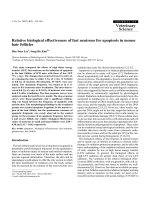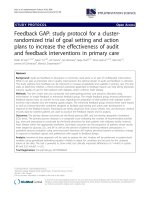EFFECTIVENESS OF INTERACTIVE PEER SCAFFOLDING (IPS) IN ENHANCING EFL LEARNER’S SPEAKING SKILL
Bạn đang xem bản rút gọn của tài liệu. Xem và tải ngay bản đầy đủ của tài liệu tại đây (830.76 KB, 66 trang )
MINISTRY EDUCATION AND TRAINING
CAN THO UNIVERSITY
TRẦN THỊ MỸ LINH
EFFECTIVENESS OF INTERACTIVE PEER SCAFFOLDING (IPS) IN
ENHANCING EFL LEARNER’S SPEAKING SKILL
MASTER THESIS: EDUCATION
Program: Principles and Methods in English Language Education
Program code: 60 14 01 11
CAN THO – OCTOBER, 2020
MINISTRY EDUCATION AND TRAINING
CAN THO UNIVERSITY
TRẦN THỊ MỸ LINH
EFFECTIVENESS OF INTERACTIVE PEER SCAFFOLDING (IPS) IN
ENHANCING EFL LEARNER’S SPEAKING SKILL
MASTER THESIS: EDUCATION
Program: Principles and Methods in English Language Education
Program code: 60 14 01 11
CAN THO – OCTOBER, 2020
Effectiveness of interactive peer scaffolding (IPS) in enhancing EFL learner’s speaking skill
Luận văn Thạc sĩ với đề tài:
“EFFECTIVENESS OF INTERACTIVE PEER SCAFFOLDING (IPS) IN
ENHANCING EFL LEARNER’S SPEAKING SKILL”
do học viên Trần Thị Mỹ Linh thực hiện dưới sự hướng dẫn khoa học của TS.
Nguyễn Thị Phương Hồng và báo cáo đã được Hội đồng chấm luận văn thông qua
Effectiveness of interactive peer scaffolding (IPS) in enhancing EFL learner’s speaking
skill
Thư ký
Ủy viên
(Ký tên)
(Ký tên)
…………………………..
……………………………..
GV phản biện 1
GV phản biên 2
(Ký tên)
(Ký tên)
……………………………
…………………………….
Cần Thơ, ngày
tháng
2020
Chủ tịch Hội đồng
(Ký tên)
…………………………….
i
Effectiveness of interactive peer scaffolding (IPS) in enhancing EFL learner’s speaking skill
DECLARATION
This thesis entitled “EFFECTIVENESS OF INTERACTIVE PEER SCAFFOLDING
(IPS) IN ENHANCING EFL LEARNER’S SPEAKING SKILL” is conducted under the
supervision of Dr. Nguyen Thi Phuong Hong, an English instructor at the English
Department, Can Tho Univeristy.
I declare that the information reported in this study is the result of my own work except
where due reference is made. The thesis has not been accepted for any degree and is not
concurrently submitted to any candidature for any other degree or diploma.
Can Tho, October 2020
Trần Thị Mỹ Linh
ii
Effectiveness of interactive peer scaffolding (IPS) in enhancing EFL learner’s speaking skill
ACKNOWLEDGEMENTS
This MA thesis would not have been completed without the support from many
people. On this occasion, I hereby would like to send my big thanks to these people.
I would like to express my grateful acknowledgement to my supervisor, Dr.
Nguyen Thi Phuong Hong for her patient guidance, valuable time counseling, giving
useful feedback as well as a big support during the time of conducting the study. Thank
you from the bottom of my heart for everything that you have done for me
My sincere thanks go to all EFL students who participated to response my
questionnaire in this study and my kind colleagues who support me during my data
collection time.
Finally, I also own a big debt of gratitude to my family members who were always
by my side and provided me with everything to gain the valuable achievement throughout
my career path and academic success.
Can Tho, October 2020
iii
Effectiveness of interactive peer scaffolding (IPS) in enhancing EFL learner’s speaking skill
ABSTRACT
The research topic is "Effectiveness of interactive peer scaffolding (IPS) in enhancing EFL
learner’s speaking skill" was conducted to discover the effectiveness of peer-to-peer
scaffolding for improving learners' speaking skills. The research was conducted based on
primary data collected from a two-part questionnaire, the current status of using IPS and
the effectiveness of IPS of 96 survey participants, who are all EFL learners. English
language at Can Tho University and observation method of speaking classroom before
applying peer scaffolding method and when using peer scaffolding in an English speaking
classroom at Can Tho University.
The research results show that at Can Tho University, the application of IPS method in
speaking lessons is still only average, not really regular. Peer interaction has brought about
many positive changes in students' speaking skills. In addition, by observing the two cycles
of a speaking class of EFL students at Can Tho University, students' speaking skills have
been significantly improved when applying the IPS method, helping students take care of
I listen to the lecture more, the class is receptive. More seriously, students confidently share
their opinions and actively participate in classroom learning activities.
iv
Effectiveness of interactive peer scaffolding (IPS) in enhancing EFL learner’s speaking skill
TÓM TẮT
Đề tài nghiên cứu “Hiệu quả của việc tương tác hỗ trợ nhằm nâng cao kỹ năng nói của
sinh viên ngoại ngữ” được thực hiện để tìm ra sự hiệu quả của việc sinh viên hỗ trợ đối
với việc nâng cao kỹ năng nói của người học . Nghiên cứu được tiến hành dựa trên dữ
liệu sơ cấp thu thập được từ bảng câu hỏi bao gồm hai phần là sự thường xuyên của việc
sử dụng IPS và hiệu quả việc sử dụng IPS của 96 người tham gia khảo sát, họ đều là sinh
viên học tiếng Anh tại trường Đại học Cần Thơ và phương pháp quan sát lớp học mơn
nói trước khi áp dụng phương IPS trong một lớp học nói tiếng anh tại trường Đại học Cần
Thơ.
Kết quả nghiên cứu cho thấy tại Trường Đại học Cần Thơ, việc áp dụng phương pháp IPS
trong các tiết học nói vẫn chỉ ở mức độ trung bình, chưa thực sự thường xuyên. Sự tương
tác hỗ trợ đã mang lại nhiều thay đổi tích cực trong việc cải thiện kỹ năng nói của học
sinh. Ngồi ra, qua quan sát hai chu trình của một tiết học nói của sinh viên họcTiếng
Anh tại trường Đại học Cần Thơ cho thấy kỹ năng nói của sinh viên được cải thiện rõ rệt
sau khi áp dụng phương pháp IPS, giúp sinh viên chăm chú nghe giảng hơn, lớp học tiếp
thu. nghiêm túc hơn, học sinh tự tin chia sẻ ý kiến của mình và tích cực tham gia các hoạt
động học tập trên lớp
Từ khóa: tương tác hỗ trợ, kỹ năng nói
v
Effectiveness of interactive peer scaffolding (IPS) in enhancing EFL learner’s speaking skill
TABLE OF CONTENTS
Contents
CHAPTER ONE ........................................................................................................................... 1
INTRODUCTION......................................................................................................................... 1
1.1 Rationale ............................................................................................................................................. 1
1.2 Research aims ..................................................................................................................................... 2
1.3 Research questions .............................................................................................................................. 2
1.4 Hypotheses .......................................................................................................................................... 3
CHAPTER TWO .......................................................................................................................... 5
LITERATURE REVIEW ............................................................................................................ 5
2.1 DEFINITION OF SCAFFOLDING ................................................................................................... 5
2.2. ZONE OF PROXIMAL DEVELOPEMENT .................................................................................... 6
2.2.1 Sociocultural theory ..................................................................................................................... 6
2.2.2 Zone of proximal development .................................................................................................... 7
2.2.3 ZPD assessment ........................................................................................................................... 9
2.2.4. ZPD and scaffolding ................................................................................................................. 10
2.3 FEATURES AND DISCIPLINES .................................................................................................... 12
2.3.1 Features of scaffolding ............................................................................................................... 12
2.3.2. Disciplines of scaffolding ......................................................................................................... 14
2.4. PEER SCAFFOLDING IN SECOND LANGUAGE LEARNING RESEARCH ........................... 15
2.5 THE EFFECTIVENESS OF INTERACTIVE SCAFFOLDING AMONG PEERS ........................ 16
2.5.1 Scaffolding and achievement ..................................................................................................... 18
2.5.2. Scaffolding, task effort and appreciation of support ................................................................. 20
2.5.3 Support contingency and independent working time in scaffolding small-group work. ........... 22
CHAPTER THREE .................................................................................................................... 23
RESEARCH METHODOLOGY .............................................................................................. 23
3.1 Significance of research .................................................................................................................... 23
3.2 RESEARCH DESIGN ...................................................................................................................... 23
3.3 PARTICIPANTS .............................................................................................................................. 24
3.4 INSTRUMENTS............................................................................................................................... 25
3.5 PROCEDURE ................................................................................................................................... 25
3.6 DATA COLLECTION ..................................................................................................................... 26
vi
Effectiveness of interactive peer scaffolding (IPS) in enhancing EFL learner’s speaking skill
3.7 DATA ANALYSIS ........................................................................................................................... 28
CHAPTER FOUR ....................................................................................................................... 30
RESULTS .................................................................................................................................... 30
4.1 THE FREQUENCY OF USING IPS IN SPEAKING CLASS ........................................................ 30
4.2. THE EFFECTS OF INTERACTIVE PEERS SCAFFOLDING .................................................... 34
4.3. OBSERVATION ............................................................................................................................. 36
CHAPTER 5 ................................................................................................................................ 39
DISCUSSION AND CONCLUSION ........................................................................................ 39
5.1. SUMMARY OF THE STUDY ........................................................................................................ 39
5.2. DISCUSSION .................................................................................................................................. 39
5.3. IMPLICATIONS ............................................................................................................................. 41
5.4. LIMITATIONS ................................................................................................................................ 42
5.5. RECOMMENDATIONS FOR FURTHER RESEARCH ............................................................... 42
REFERENCES ............................................................................................................................ 44
APPENDICES ............................................................................................................................. 46
APPENDIX A ......................................................................................................................................... 46
QUESTIONNAIRE ................................................................................................................................ 46
APPENDIX B ......................................................................................................................................... 52
OBSERVATION SHEET ....................................................................................................................... 52
APPENDIX C ......................................................................................................................................... 53
RELIABILITY ........................................................................................................................................ 53
vii
Effectiveness of interactive peer scaffolding (IPS) in enhancing EFL learner’s speaking skill
LIST OF TABLES
Table 3.1 Statistics questionnaire survey results on using IPS in speaking class…15
Table 3.2 Statistics questionnaire survey results on the effectiveness of using
IPS in speaking class… ............................................................................... ……17
viii
Effectiveness of interactive peer scaffolding (IPS) in enhancing EFL learner’s speaking skill
CHAPTER ONE
INTRODUCTION
In this chapter, I describe main reasons why interactive peer scaffolding is worth being
researched in the context of acquiring English proficiency among EFL learners. Research
aims, research questions, hypotheses and organization of the study are also given.
1.1 Rationale
The process of learning a language in general and English in particular requires a
number of strategies and methods which may serve as effective tools to boost a learner’s
linguistic proficiency and to help them achieve their goals. Interactive scaffolding,
therefore, is one of those instructional boosters providing language pursuers opportunities
to experience different interaction-based situations as well as to deal with problems which
may emerge in the process of learning a language. English acquirement has a close
connection with continued interactions among individuals. However, due to the differences
in every learner’s capabilities, the interactive process might be hindered. Thus, Scaffolding,
in this case, is required to support those who with poorer English performances.
Despite being trained for many years, the majority of students in Vietnam mainly
expose to English grammar delivered on papers rather than communication skills which
are the key to language acquisition. Given that case, it is concluded that they possibly fail
to perform any speaking tasks in a natural way. Hence, interactive scaffolding would assist
English learners in coping with a host of difficulties, occurring in daily communicative
situations, such as a lack of vocabulary, ideas, incomplete non paper-based grammar, or
incorrect pronunciation . When those hinderances are overcome, speaking skills will be
mastered, making language learning process easier, faster and transferable.
1
Effectiveness of interactive peer scaffolding (IPS) in enhancing EFL learner’s speaking skill
Interactive scaffolding may also help both competent and incompetent learners to
combat psychological problems during the course of learning English, specifically,
speaking skills. In fact, a classroom setting may hold culturally-divergent students who are
probably inexperienced in interactive skills and unfamiliar with classroom social discourse.
That might trigger hesitancy preventing learners from mastering verbal skills. With the
interference of interactive scaffolding, every individual will grasp a chance of being
intellectually and emotionally supported, as a result, their performances in English
acquisition would be enhanced. In addition, reticence is a common problem in the context
of Asian classrooms where students are too shy to ask questions, so this technique is also
significant to reticent students who might overcome their shyness, reticence and attain their
goals.
This way of teaching has been being applied on global educational system but it is
still new to Vietnamese one, especially at Can Tho University. The term “Scaffolding” is
still ambiguous to a number of teachers and English learners. Therefore, it is worth
conducting this research to measure how popular this teaching approach is employed and
what effects it may bring about to English learners.
1.2 Research aims
This study was designed to investigate how popularly interactive scaffolding is used
among EFL classes and what effects learners may have from it.
1.3 Research questions
Based on the research aims, this study attempts to find out the answers to the
following questions:
2
Effectiveness of interactive peer scaffolding (IPS) in enhancing EFL learner’s speaking skill
1. To what extent interactive peer scaffolding is applied in EFL classes?
2. What are positive outcomes EFL learners might have by applying interactive
scaffolding?
1.4 Hypotheses
1. Peer interactive scaffolding is only used in EFL classes when students are asked.
2. Interactive scaffolding has positive impacts on EFL learners:
•
Enhance their confidence
•
Improve their range of vocabulary
•
Grammar and pronunciation mistakes can be corrected
•
Become more fluent and interactive
•
Boost their general verbal abilities
1.5 Organisation of the study
This thesis is organized into five following chapters including (1) Introduction, (2)
Literature Review, (3) Methodology, (4) Results(5) Discussion, Conclusion, Limitations
and Suggestions.
In chapter 1, all the rationale, aims, research questions, research hypotheses and
the organization of the research are presented.
Chapter 2 concentrates on a general view of the relevant studies to this thesis and
gives definitions of key terms used in the study.
3
Effectiveness of interactive peer scaffolding (IPS) in enhancing EFL learner’s speaking skill
Chapter 3 focuses on the significances of research, research design, participants,
instruments and procedures, data analysis.
Chapter 4 reports the findings from the questionnaire responses and observation.
After data is collected from the participants, it will be analyzed by the software SPSS
(Statistics Package for the Social Sciences).
Chapter 5 gives a summary of the main findings of the study along with the
discussion. Some limitations are mentioned after that and some suggestions for further
studies in this chapter are also presented .
4
Effectiveness of interactive peer scaffolding (IPS) in enhancing EFL learner’s speaking skill
CHAPTER TWO
LITERATURE REVIEW
This chapter provides a review on existing literature of scaffolding. Furthermore, it also
gives a summary of some significant studies in relation to this aspect. Finally, the chapter
concludes with the justification of this present study.
2.1 DEFINITION OF SCAFFOLDING
Since its birth, the term scaffolding has experienced various interpretation and
operation in different contexts such as formal classrooms, parent-child interaction, adult
education, mainstream education as well as L2 education. The significance of scaffolding
has been broadened to the extent that who provides scaffolding is no longer a question, as
“expertise” rather than “experts” is becoming the focus (Carmichael-Wong & Vine, 2004).
Its use is no longer restricted to face-to-face interaction between an adult/expert and a
child/novice. For example, many researchers have now considered peer collaboration (e.g.
Barnard, 2002; De Guerrero& Villamil, 2000; Shehadeh, 2011; Storch, 2007; Van Lier,
2004; Walqui, 2006) and interaction between a teacher and a classroom full of students as
scaffolding (e.g. Davis & Miyake, 2004; Many, Dewberry, Taylor, & Coady, 2009).
The term “scaffolding” was conceptualized by Wood, Bruner and Ross (1976),
regarding a kind of assistance provided by a more capable person to a less capable one.
Capable people include not only teachers, experts but also include more knowledgeable
peers who will help the learner to achieve language skills. Also, according to (Wood,
Bruner, & Ross, 1976, cited in Lantolf, &Appel, 1994, p. 40), scaffolding is a discursive
mechanism which occurs in “the social interaction that a knowledgeable participant can
create, by means of speech, supportive conditions in which the novice can participate in,
and extend current skills and knowledge to higher levels of competence”.
5
Effectiveness of interactive peer scaffolding (IPS) in enhancing EFL learner’s speaking skill
In the process of scaffolding, the teacher helps the student to understand a notion
or a concept and complete the task that the student has difficulty figuring it out individually
in the beginning. With the teacher’s assistance, the student’s capabilities and skills can be
exceeded. The most important feature of scaffolding is that the student is permitted to
participate in different activities and then that one enables to do unassisted tasks by
his/herself. The student can’t help making mistakes which are within the teacher’s
expectation but he or she is able to complete the task or attain his or her goals thanks to the
teacher’s continual assessment and constructive feedback. The student is mainly
responsible for mastering the task and will work independently from the teacher as long as
he or she gets understood what the teacher conveys to him or her. This process is call
“fading” or the gradual removal of scaffolding. Scaffolding which acts as a knowledgelike bridge enables students to reach what they do not now based on what they have known
before. If scaffolding is appropriately executed, it will play a role as an enabler rather than
a disabler (Benson, 1997).
2.2. ZONE OF PROXIMAL DEVELOPEMENT
2.2.1 Sociocultural theory
Sociocultural Theory (SCT) is an approach to human sciences with the purpose of
explaining and developing a connection between mental functioning and the cultural,
institutional and historical conditions in which mental functioning happens (Van Lier, 2004
as cited in Pishghadam & Ghadiri, 2011). It directly emphasizes the link between social
context and individuals’ psychological development (Bruffee, 1993, 1996; Gere, 1987 as
cited in Tsai, 2006). Vygotsky (1978, 1981 &1987) is fundamentally concerned with the
thesis that the development of human cognitive functions proceeds from the social or
interpsychological plane to the individual or intrapsychological plane, with the use of
symbolic, socioculturally developed tools the most important of which is language.
In other words, SCT regards human mental functioning as necessarily a mediated
process which is organized by artifacts, activities and concepts (Lantolf, 2000). In addition,
6
Effectiveness of interactive peer scaffolding (IPS) in enhancing EFL learner’s speaking skill
as Lantolf & Thorne (2007) point out, although Vygotsky does not reject the
neurobiological factors for the development of higher order thinking ability he mainly
focuses on the significance of interaction occurring within social contexts for developing
human cognitive ability. Generally, in SCT learners are treated as active meaning-makers
and problem-solvers in their process of learning with the great emphasis on the learning
which stems from interaction and negotiations of meaning among individuals.
The notion of ZPD is considered significant in SCT since it is the region in which
the transition from interpsychological functions turns into intrapsychological functions. It
is believed that a variety of internal developmental functions will be activated by learning
and this process only happens provided that the child interacts with the peers or adults in a
social environment (Fahim & Haghani, 2012). However, it should be mentioned that the
current view of the ZPD has been expanded beyond the interaction between an expert and
a novice. Recent research seeks to gain a better understanding on how L2 learning is
mediated in the ZPD by looking more closely at peer interactions in the ZPD. In other
words, ZPD is considered as providing an opportunity to learn with and from others
(Anton, 1999; Lantolf, 2000; Wells, 1998).
2.2.2 Zone of proximal development
The concept of zone of proximal development (ZPD) was developed by Lev
Semenovich Vygotsky during the late 1920s and elaborated progressively until his death
in 1934. In Mind in Society: The Development of Higher Psychological Processes,
Vygotsky defined the ZPD as “the distance between the actual development level as
determined by independent problem solving and the level of potential development as
determined through problem solving under adult guidance or in collaboration with more
capable peer” (p. 86). That is, the ZPD was understood by Vygotsky to describe the current
or actual level of development of the learner and the next level attainable through the use
of mediating semiotic and environmental tools and capable adult or peer facilitation. The
idea is that individuals learn best when working together with others during joint
7
Effectiveness of interactive peer scaffolding (IPS) in enhancing EFL learner’s speaking skill
collaboration, and it is through such collaborative endeavors with more skilled persons that
learners learn and internalize new concepts, psychological tools, and skills.
Roosevelt (2008) holds that the main goal of education from Vygotskian perspective
is to keep learners in their own ZPDs as often as possible by giving them interesting and
culturally meaningful learning and problem-solving tasks that are slightly more difficult
than what they do alone, such that they will need to work together either with another, more
competent peer or with a teacher or adult to finish the task. The idea is that after completing
the task jointly, the learner will likely be able to complete the same task individually next
time, and through that process, the learner’s ZPD for that particular task will have been
raised. This process is then repeated at the higher level of task difficulty that the learner’s
new ZPD requires. This concept is illustrated in Figure 1. (Campbell ,2008, p. 3).
Vygotsky (1962) introduced the concept of ZPD to criticize the psychometric-based
testing in Russian schools. The traditional testing reflected only the current level of
learners’ achievement, rather than learner’s potential for development in future .The zone
of actual development(ZAD)does not sufficiently describe development. Rather, it reflects
what is already developed or achieved. The level of assisted performance in ZPD highlights
the potential for emerging behavior and “tomorrow of development” (Vygotsky, 1978).
Cole & Cole (2001) point out that the term proximal indicates that the assistance
provided goes just slightly beyond the learner’s current competence complementing and
building on their existing abilities. Yaroshevky (1989) indicates that that the link between
education and development is manifested in Vygotsky's idea of ZPD. Verenikina (2003)
points out that to arrive at this position Vygotsky had to overcome two types of
reductionism - biological, which is the normal maturing of the physical brain and
sociological, the appropriation by the learner of society's cultural assets (language, etc)
thrust upon it by adults (p.4). It is within this latter area that Vygotsky placed his ZPD by
arguing that rather than having education dragging behind in sociological development it
8
Effectiveness of interactive peer scaffolding (IPS) in enhancing EFL learner’s speaking skill
must anticipate it - it must "run ahead as the adult helps the learner to climb the next
step"(Yaroshevsky, 1989, p.277).
Vygotsky recognized that the distance between doing something independently and
with the help of another indicated stages of development, which do not necessarily coincide
in all people. In this way he regarded an instructor’s "teaching of a student not just as a
source of information to be assimilated but as a lever with which the student's thought, with
its structural characteristics, is shifted from level to level".(Yaroshevsky, 1989, p.283,cited
in Verenikina, 2003, p.4)
2.2.3 ZPD assessment
Chaiklin (2003) believes that as a first step for understanding how Vygotsky
formulated the zone of proximal development, it is important to remember that Vygotsky’s
interest is to develop a theoretical basis for appropriate pedagogical interventions,
including principles for possible instructional grouping of learners and identification of
specific interventions for individual learners. Interventions must be based on diagnostic
procedures based on a learner’s current state of development.
Vygotsky (1998) indicates that “a true diagnosis must provide an explanation,
prediction, and scientific basis for practical prescription” (p, 205). Chaiklin (2003) asserts
that a solution to the diagnostic problem is identical with having an explanatory theory of
psychological development. Vygotsky proposes that the zone of proximal development as
a diagnostic principle “allows us to penetrate into the internal causal-dynamic and genetic
connections that determine the process itself of mental development” (p. 203). To
understand Vygotsky’s initial proposal of ZPD, a theoretical explanation of how ZPD
operates to assess an individual learner is needed .To make things clear, we have to
consider Vygotsky's notion of imitation, around which his analysis is constructed.
Chaiklin (2003) points out that a person’s ability to imitate, as conceived by
Vygotsky, is the basis for a zone of proximal development. Imitation, as used here, is not
9
Effectiveness of interactive peer scaffolding (IPS) in enhancing EFL learner’s speaking skill
a mindless copying of actions (Vygotsky 1997, p. 95). Rather, Vygotsky wants to break
from a copying view, to give a new meaning to imitation – reflecting a new theoretical
position – in which imitation presupposes some understanding of the structural relations in
a problem that is being solved (Vygotsky1987, p. 210). Vygotsky holds that a learner is
not able to imitate anything ,“imitation is possible only to the extent and in those forms in
which it is accompanied by understanding” (Vygotsky, 1997, p. 96). “It is well established
that the child can imitate only what lies within the zone of his intellectual potential”
(Vygotsky, 1987, p. 209).
Vygotsky(1997)attempted to avoid imitation misunderstandings, because he
considered it as “one of the basic paths of cultural development of the child” (p. 95). In
Vygotsky’s texts the term imitation should be read with an awareness that a special
technical meaning is intended. We can now consider how the concept of imitation provides
a theoretical justification for how to assess a learner’s zone of proximal development. “The
area of immature, but maturing processes makes up the child’s zone of proximal
development” (Vygotsky, 1998b, p. 202). For a given learner, these maturing functions are
more or less developed but unable to support independent performance. Independent
performance cannot provide evidence of what maturing functions are present (Elkonin,
1998).
2.2.4. ZPD and scaffolding
It is widely believed that socio-cultural theory of mind and the concept of ZPD form
the basis of the notion of scaffolding (Berk, 2001; Daniels, 2001; Wells, 2001). However,
the interpretations and explanations of the exact ways that scaffolding relates to it have
been different. In addition, the limitations of the metaphor of scaffolding in interpreting the
zone of proximal development have been revealed (Stone, 1998 cited in Verenikina, 2003,
p. 2). Wells (1999) defined scaffolding as "a way of operationalizing Vygotsky's (1987)
concept of working in the zone of proximal development". He recognized three key
features that give educational scaffolding its particular character: 1) the essentially dialogic
10
Effectiveness of interactive peer scaffolding (IPS) in enhancing EFL learner’s speaking skill
nature of the discourse in which knowledge is co-constructed; 2) the significance of the
kind of activity in which knowing is embedded and 3) the role of artifacts that mediate
knowing (Wells, 1999, p.127).
The major goal of scaffolding in teaching represents view the ZPD characteristic of
transfer of responsibility for the task to the student (Mercer and Fisher, 1993). They
emphasize the collaboration between the teacher and the learner in constructing knowledge
and skill. Other authors see the metaphor of scaffolding as limited compared to the notion
of ZPD. Lave and Wenger (1991) point out that the notion of ZPD which emphasizes
teacher-learner collaboration and negotiation as bilateral process contrasts scaffolding that
captures teaching performance as a one-way communication process.
In scaffolding, the scaffolder constructs the scaffold alone and presents it for the use
of the novice (Daniels, 2002, p. 59). Stone (1984) expressed the concern that the metaphor
of scaffolding can lead to viewing the teacher-learner interaction in the classroom as
predominantly adult-driven and one-sided in nature. This view, if applied to classroom
teaching, might take educators back to a pre-Piagetian, traditional way of teaching through
direct instruction(Verenikina, 2008).
The cognitive constructivism of Piaget views learners as active constructors of their
world view and discoverers of knowledge, on the other hand Vygotsky’s social
constructivism which is built on Piaget’s ideas of active learners focuses on social
interaction in learning and development. The quality of teacher-learner interaction is seen
as crucial when scaffolding learner’s learning (Bodrova & Leong, 1996). Stone (1998)
highlighting the limitations of the scaffolding metaphor, reveals that a number of
educational and developmental psychologists are questioning the theoretical and practical
value of the metaphor. However, he concludes, the metaphor should not be abandoned
(Stone, 1998, p.351).
11
Effectiveness of interactive peer scaffolding (IPS) in enhancing EFL learner’s speaking skill
2.3 FEATURES AND DISCIPLINES
2.3.1 Features of scaffolding
According to Wood, scaffolding is developed with six features: (a) recruiting the
tutee’s interest in the task; (b) reducing the degree of freedom in the task to make it
manageable to the tutee; (c) maintaining goal direction; (d) marking
critical features; (e) controlling frustration; and (f) modelling solutions to the task. They
argue further that scaffolding may eventually lead to “development of task competence by
the learner at a pace that would outdo his unassisted efforts” (p. 90). In the field of language
learning, Van Lier (2004) notes six features of scaffolding:
1) Continuity: repeated occurrences over time, with variations connected to one another.
Continuity was met as every session the pairs were required to write a complete
argumentative essay, building on their past knowledge of the genre which have been
developed in the previous sessions. Out of class collaboration on revising their essays based
on peers or teacher feedback and comments also enabled the learners to link the past and
future interaction.
2) Contextual support: a safe but challenging environment, errors are expected and
accepted as part of the learning process. Contextual support was initially provided by the
explanations and clarifications on the argumentative genre by the tutor and with the peer
discussions between the members of the dyads. Another layer of the contextual support
was created by the students themselves when deciding to argue for or against a topic
and providing supports for their arguments. The challenge was to co-construct a fiveparagraph argumentative essay in the limited time of classroom hour.
3) Intersubjectivity: mutual engagement and support, two minds thinking as one.
Intersubjectivity was achieved when the pairs engaged in harmonious exploratory talk in
such cases as reformulating the statement made by one member of the dyad and seeking
confirmation of his or her understanding. There was mutual engagement and support in
12
Effectiveness of interactive peer scaffolding (IPS) in enhancing EFL learner’s speaking skill
each dyad as the members tried to pull on each other’s linguistic and extra-linguistic
knowledge of the mechanical as well as contextual aspects of the essay at hand. In this way
they were involved in the knowledge transmission, receiving and taking suggestions and
working toward a common goal, namely co-constructing a comprehensive essay.
4) Contingency: the scaffolding support depends on learners’ reactions, elements can be
added, changed, deleted, repeated, etc. Contingency was met during drafting and revision
phases of the writing process as the assistance provided by the more capable peer was
contingent upon what has been done in the previous stages of the writing process, thus,
elements were changed, added or deleted accordingly. More specifically in the drafting
phase it was observed that the more capable peer who had taken the role of a consultant
tried to build a trustful atmosphere ensuring the less competent peer that what he or she
says regarding for instance spelling or choice of a particular term was right. This made the
peers’ varied comprehension and interpretation to be brought in the surface of discourse
and it was reconstructed and refined through contingent interaction (Barnard & Campbell,
2005).
5) Handover/Takeover: there is an increasing role for the learner when skills and
confidence increase. Handover was employed when at the end of each writing task the
peers reached agreement on what they were supposed to write in each section of the essay
including introduction, body, and conclusion, or what should be added to them. Thus,
before submitting their essay to the teacher, the learners achieved a measure of control over
their writing process through interdependent activity. (Ibid.)
6) Flow: communication between participants is not forced, but flows in a natural way.
Flow was achieved as the interaction between the peers in
each dyad was
the
characteristic of easy, unforceful conversations. The peers addressed each other and
talked comfortably when sharing ideas and discussing different aspects of their writing.
13
Effectiveness of interactive peer scaffolding (IPS) in enhancing EFL learner’s speaking skill
2.3.2. Disciplines of scaffolding
In the context of EFL classroom, the learner’s language can be scaffolded by the
teacher in a host of essential ways based on disciplines as follows:
1.
Motivating the learner to work on a given task in the target language
2.
Defining the number of task steps related to the learners’ current ability
3.
Diagnosing discrepancies between the learner’s production and obtainment of the
ideal solution
4.
Controlling learners’ frustration and risk to find new solutions.
Specifically, teachers encourage students to perform a practical task in which the
requirement of targeted language skill is apparent. Secondly, to finish a chosen task, the
teacher’s clarification will be put into logical steps. Thirdly, the teacher can deliver to
students assessment on how well they understand the task or any challenge they face. After
this step is completed, the teacher can show constructive solutions to the previous problems
by assisting them in defining their own feelings and relevant classroom experiences.
As EFL students become proficient at doing more complex English language tasks,
the amount of teacher and peer supports can be decreased or removed entirely. This part of
scaffolding is known as “fading”. The component of “fading” is characterized as the
continual revision of the scaffolded parameters in response to emerging capabilities of the
novice (Rogoff, 1990). A second component of scaffolding is called “internalization”
(Wertsch, 1991). The internalization of scaffolded performance is said to occur whenever
the learner experiences an internalized dialogue which is supposed to promote his or her
use and acquisition of knowledge as it is co-constructed in a shared activity.
The theoretical basis for scaffolding in EFL is well-established. Scaffolding as a
strategy was first predicated on a social constructivist approach that linguistic development
14
Effectiveness of interactive peer scaffolding (IPS) in enhancing EFL learner’s speaking skill
takes place through social interaction in a historical-cultural context. In the social
constructivist theory, Vygotsky (1986) claimed that all children learn through some sort of
interpersonal activity, and that learning manifests itself first as social interaction and
secondly as internalization (cited in Ellis, 1997).
2.4. PEER SCAFFOLDING IN SECOND LANGUAGE LEARNING RESEARCH
Peers play a pivotal role in shaping a child’ values and behaviors and encouraging
his or her development and socialization. In the classroom, teachers are supposed to deal
with a number of social and emotional matters which may deprive them of their time for
academic program. For instance, it is challenging for teachers to establish a collaborative
learning environment where there are anti-social behaviors, penetrators or victims of
bullying; as a result, students fail to collaborate with others in academic activities. When
they do not succeed in developing constructive peer relationship, they might encounter
social and psychological obstacles and the potential of unsuccessful academic
performances would move in tandem. Therefore, it is believed that peer scaffolding serves
as an effective tool to maximize student learning.
Collaborative learning is a pedagogy that is student-centred and values-focused so
it is compatible with research where students are encouraged to examine their values,
develop mutual respect and learn how to work together. It is often used when referring to
sociocultural perspectives on learning where primacy is given to knowledge as a social
rather than individual concept and supports the premise of using the collective knowledge
of peers. Ideally, when there are students who have different backgrounds, knowledge and
experience, ideas are exchanged that allow the individual to question their perspective and
learning to occur (Battistich & Watson, 2003). This suggests a more flexible approach to
teaching where students have increasing control over the experience of working in a group
(Hart, 1992) and a level of independence. But there are assumptions that students have
developed communication and interpersonal skills to work together ( Gillies & Ashman,
15









